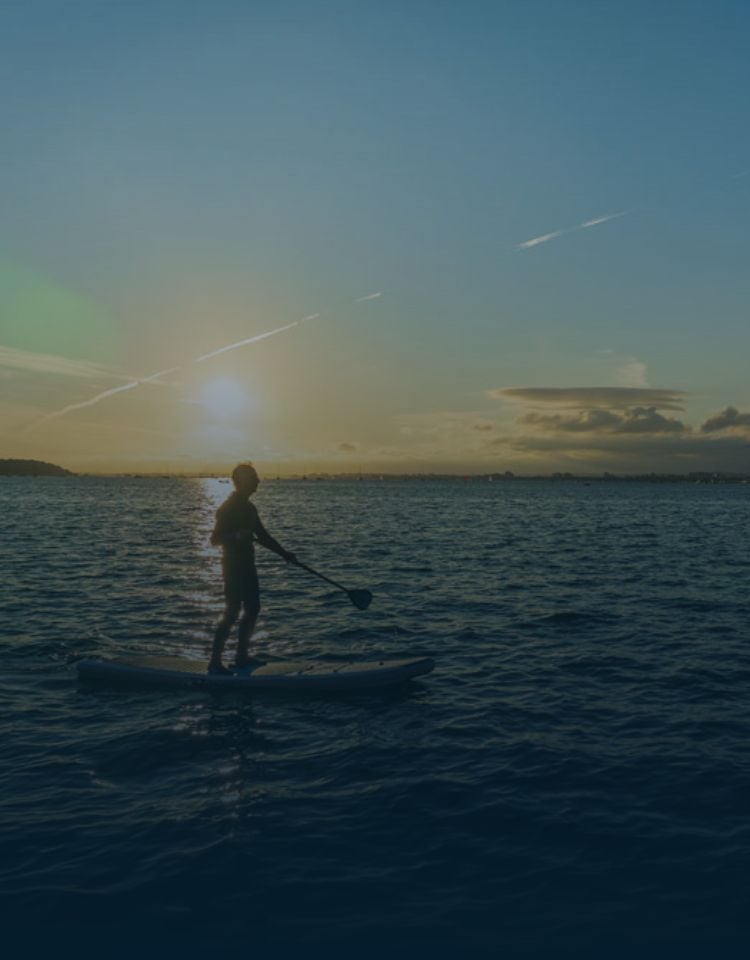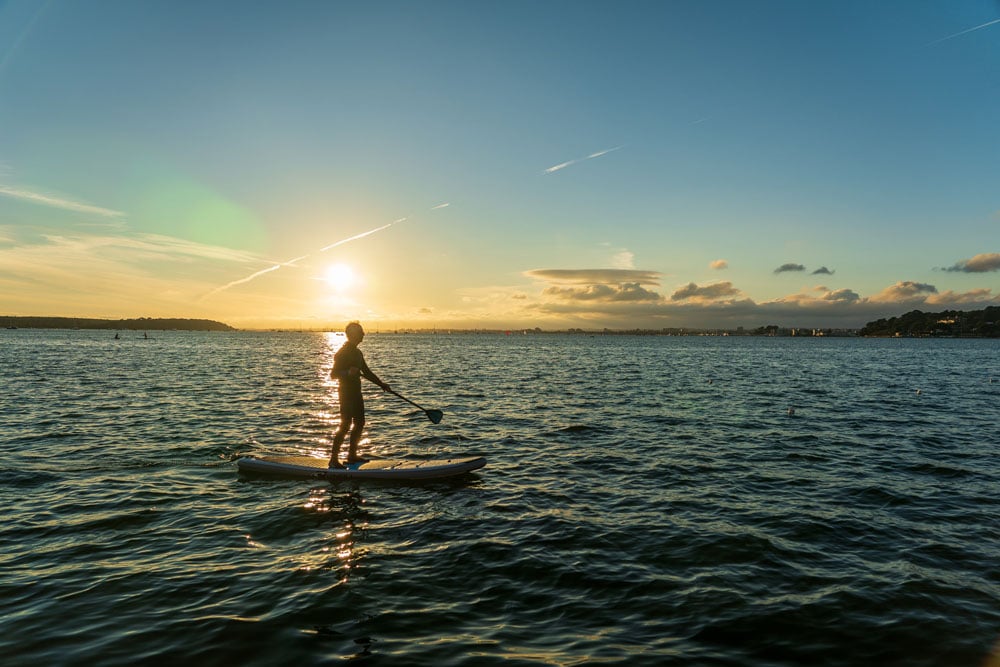Written By: Lindsay Charles and Emma Pedota, Summer Student
Certain safety equipment is required while onboard a stand-up paddleboard (SUP boarding), canoe, and kayak as these human-powered boats are subject to the Small Vessel Regulations.[1] For example, if you’re operating a paddleboard, kayak, or canoe without a personal flotation device (PFD), you could be fined $200 plus $100 for each missing flotation device and be subject to provincial surcharges. The required equipment must be carried on board, be in good working order, maintained according to the manufacturer’s instructions, and available immediately in case of an emergency.[2]
MANDATORY SAFETY EQUIPMENT REQUIREMENTS FOR STAND UP PADDLEBOARDS (SUP)
If you are SUP boardings for non-navigational purposes, such as doing yoga or surfing, you do not need to bring any of the following equipment with you.
| SAFETY EQUIPMENT: | TYPE: | DESCRIPTION: |
| PFD | Personal Lifesaving Appliance | You are required to wear a Canadian-approved PFD. Inflatable PFDs are not legal for white-water paddling as they are not inherently buoyant.[3] For a PFD to meet safety regulations you have to be wearing it while you’re on the water.
Inflatable PFDs are prohibited for children under 16. |
| Sound Signalling Device | Audio Signal | A sound signaling device can be in the form of a whistle, pealess whistle, air horns, etc., and often come with an approved PFD.
|
| Flashlight | Visual Signal | If your paddleboard is more than 6 meters long, as is the case with most paddle boards, you will need a watertight flashlight.
A flashlight is especially important when paddleboarding before sunrise, at sunset, or in any condition with reduced visibility.
|
OPTIONAL SAFTEY EQUIPTMENT
If you are wearing a PDF of appropriate size and paddling in a kayak or SUP board after sunset or before sunrise or in conditions of restricted visibility, you are only required to carry a sound-signaling device and a watertight flashlight. However, there are other safety devices that can increase your safety in an emergency situation when SUP boarding.
| SAFETY EQUIPMENT: | TYPE: | DESCRIPTION: |
| Ankle or Waist belt Leash
|
Personal Lifesaving Appliance | This is a cord that attaches to the rear of your board and then connects to your ankle via ankle cuff.
If you fall off your paddleboard, your leash will ensure that the board does not drift away from you and remains attached.
Parks Canada recommends the use of an appropriate ankle or waistbelt leash. While Transport Canada has supported the use of a leash while paddleboarding, they have emphasized that it is not a replacement for PFDs.
|
| Flares | Visual Signal | If you plan on paddling somewhere that’s more than 1.852km (one nautical mile) you are required to carry 6 flares.
Even if you’re exempt, it’s important to turn your mind to where and when you will be paddling, and whether carrying flares may assist you in a foreseeable emergency situation.[4]
|
| Radar Reflector | Navigation Equipment | A radar reflector is not required for boats under 20m, however small, non-metal boats such as paddleboards are not detected on the radar systems of larger boats.
In high traffic waters or in restricted visibility a GPS and a radio will advise bigger boats of your location and limit the potential of a collision.
|
| Compass | Navigation Equipment | If your boat is less than 8m long and you’re paddling within sight of navigation marks, you’re not required to have a compass. However, a compass can be useful if you are paddleboarding in foggy conditions where navigation marks may be difficult to see.
|
MANDATORY SAFETY EQUIPMENT REQUIREMENTS FOR KAYAKS & CANOES
| SAFETY EQUIPMENT: | TYPE: | DESCRIPTION: |
| PFD | Personal Lifesaving Appliance | See description above |
| Sound Signalling Device | Audio Signal | See description above |
| Flashlight | Visual Signal | See description above |
OPTIONAL SAFETY EQUIPMENT FOR KAYAKS & CANOES
| SAFETY EQUIPMENT: | TYPE: | DESCRIPTION: |
| (1) Reboarding device | Personal Lifesaving Appliance | Refers to a ladder, lifting harness, or other devices that do not include part of the vessel’s propulsion unit and assist a person to gain access to the vessel from the water.[5]
|
| (1) Buoyant Heaving Line at least 15 m | Personal Lifesaving Appliance | A buoyant heaving line is a floating rope that has a soft buoyant object on the end. The line can be thrown towards a person in the water for them to hold onto while you pull them alongside.[6] |
| Flares | Visual Signal | See description above |
| Radar Reflector | Navigation Equipment | See description above |
| Bailer | Vessel Safety Equipment | See description above |
| Compass | Navigation Equipment | See description above
|
Before heading out on the water it’s important to know what mandatory equipment is required on board to ensure that you are safe while enjoying the water.
[1] Government of Canada, Safety Equipment for Pleasure Craft (continued) (June 28, 2021), online: Justice Laws Website < https://laws-lois.justice.gc.ca/eng/regulations/sor-2010-91/page-6.html>.
[2] Mandatory Safety Equipment in Canada, online: Pat’s Boating in Canada < https://boating.ncf.ca/equipment.html>.
[3] MEC, On-Water Safety: Mandatory Gear, online: Mountain Equipment Coop, < https://www.mec.ca/en/explore/mandatory-paddling-gear>.
[4] Ibid.
[5] Transport Canada, Safety Equipment (April 14, 2014), online: Government of Canada < https://tc.canada.ca/en/marine-transportation/marine-safety/4-safety-equipment>.
[6] Boat-Ed, Buoyant Heaving Lines and Lifebuoys, online: Kalkomey < https://www.boat-ed.com/canada/studyGuide/Buoyant-Heaving-Lines-and-Lifebuoys/101199_115754/#:~:text=Buoyant%20heaving%20lines%20and%20lifebuoys%20are%20personal%20lifesaving%20appliances%20that,a%20person%20in%20the%20water.>






